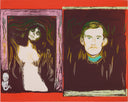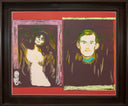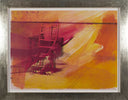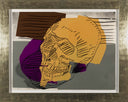Madonna and Self-Portrait w. Skeleton's Arm (After Munch) (FS.IIIA.62), 1984
Details
Year: 1984
Sheet size: 32 x 40"
Image size: 32 x 40"
Framed size: 40.5 x 47.75"
Signature: "A.W" estate stamp on verso
About the Work
"Madonna and Self-Portrait w. Skeleton's Arm (After Munch) (FS.IIIA.62)" is an estate stamped screenprint on Lenox Museum Board created by Andy Warhol in 1984. The image size is 32 x 40" and the artwork is framed in a contemporary black frame. The artwork ships framed and accompanied by a certificate of authenticity.
Andy Warhol remains one of the most influential artists of the 20th century, not only for his pioneering work in Pop Art, but for his lifelong interrogation of death, repetition, beauty, fame, and artifice. While best known for his commercial and celebrity imagery - Campbell’s Soup cans, Marilyn Monroe, and Elvis Presley - Warhol's late-career works reveal a more meditative, at times haunting, tone. The After Munch series, created just three years before his death, stands as a major example of this introspective and metaphysical phase.
In the unique screenprint Madonna and Self-Portrait with Skeleton’s Arm (After Munch) (FS.IIIA.62), (1984), Warhol engages in a rare and profoundly layered act of homage, appropriating the work of Norwegian Expressionist Edvard Munch, and in doing so, he invites the viewer into a deeply personal, psychological, and philosophical conversation that transcends time.
Each composition in this body of work is a unique variation, blending Warhol’s signature Pop aesthetic with the existential weight of Munch’s original imagery. In Madonna and Self-Portrait with Skeleton’s Arm, two of Munch’s most emotionally charged images — Madonna and his lesser-known Self-Portrait with Skeleton’s Arm — are fused into a single composition, and filtered through Warhol’s own fascination with mortality, fame, and religious iconography.
In Madonna we find a sensuous and spiritual rendering of a woman in ecstasy, her pose evoking both erotic surrender and religious reverence. Munch’s Madonna embodies the dualism of sanctity and sexuality. In Self-Portrait with Skeleton’s Arm (1895), we are confronted with an eerie portrait in which Munch gazes directly at the viewer, a skeletal forearm beneath him like a memento mori, which conjures a chilling emblem of death's proximity. The resulting combination is a disquieting yet elegant image, infused with a tension between beauty and decay, intimacy and extinction.
Both works demonstrate Munch’s obsession with liminality — the threshold between life and death, sex and suffering, creation and destruction. His images don’t just depict emotion; they embody psychological states, making the invisible visible. Motherhood and mortality intersect in Madonna, while art and death converge in Self-Portrait with Skeleton’s Arm. In each, Munch merges personal trauma (he lost his mother and sister early in life) with broader philosophical concerns, turning every gesture and object into a metaphor for the impermanence and intensity of existence.
In appropriating Munch, and bringing these two powerful works together, Warhol highlights a kindred voice, and in doing so turns the gaze inward. This is not simply homage, but a dialogue between two artists separated by nearly a century, each grappling with personal demons, religious symbolism, and existential dread, through radically different aesthetic languages.
Madonna and Self-Portrait with Skeleton’s Arm (After Munch) (FS.IIIA.62) is an expression of Warhol’s late-career vulnerability, spiritual inquiry, and intellectual ambition - a fusion of his fascination with beauty, death, and the constructed image. This print functions as a curated dialogue between two visionary minds, distilled into one silkscreen whose power is both disquieting and sublime.
About the Artist

Madonna and Self-Portrait w. Skeleton's Arm (After Munch) (FS.IIIA.62), 1984
MORE FROM THIS ARTIST
Start your collection with guidance you can trust
For nearly 50 years, we’ve helped new collectors find artwork they love and understand the stories behind each piece. Our gallery consultants offer personalized guidance, whether you’re exploring originals, limited editions, or discovering an artist for the first time. Visit your nearest gallery to start collecting with confidence.


Frequently Asked Questions
Your artwork comes with a Certificate of Authenticity (or Letter of Authenticity), professional packaging, and insured delivery.
We ship fully insured, using trusted carriers. Each piece is professionally packed to ensure safe arrival. Shipping times vary based on the location of the art, its destination, and whether or not it is framed (ready to ship) at the time of your purchase.
All our works come beautifully framed. Some print multiples may have framing options if we have unframed editions available in our warehouse. Our in-house framing provides high-quality moulding, acid-free materials and either UV plexiglass or framer’s grade acrylic. High value works may be framed in custom, closed-corner frames, and are often framed in Optium museum glass for enhanced clarity.
No, Martin Lawrence Galleries does not provide appraisal services. To ensure that appraisals are fully independent and unbiased, it is best practice for them to be carried out by certified appraisers who have not had prior involvement with the sale or handling of the artwork. For that reason, we do not appraise artworks that we handle, and instead recommend that collectors seek an independent, certified appraiser.
No, we own the vast majority of our inventory and do not seek out consignments from Sellers.
Yes, if you purchase from a local gallery, your consultant will be happy to assist you with hanging the artwork in your home.
Martin Lawrence Galleries has seven galleries across the country where you may be able to see the exact piece you are interested in. Print and sculpture multiples are more likely to be in several places for possible viewings whereas unique artworks will be constrained to one location. We are happy to facilitate your visit to one of our galleries if that is convenient for you. We can also take videos and extensive photos if a visit is not possible. Please contact us at martinlawrencegalleries.com.
We have over 50 years of experience, seven gallery locations across the United States, and a track record of connecting collectors with the right artwork.
No. Our consultants are here to guide you through the process, answer your questions, and make buying art simple and rewarding.
We encourage you to buy what you love. Our consultants will help you find the right piece that fits your taste and collection.
Please visit our page on specific instructions on how to take care of your artworks. Care Instructions
We stand by our artwork. Please review our detailed return policy here.




























